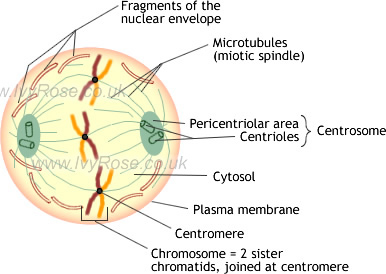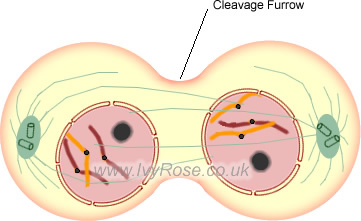Definition: Mitosis is defined as the type of cell division by which a single cell divides in such a way as to produce two genertically identical "daughter cells". This is the method by which the body produces new cells for both growth and repair of aging or damaged tissues throughout the body - as opposed to for sexual reproduction (when meiosis applies).
Mitosis is the simplest of the two ways (mitosis and meiosis) in which the nucleus of a cell can divide - as part of a process of whole cell division. The four stages of mitosis (prophase, metaphase, anaphase and telophase) are illustrated and described below.
Mitosis (Nuclear Division)
0.
|
Interphase
Interphase is not part of mitosis but is included here as a reminder that interphase preceeds mitosis.
(Hence, it has the number 0.)
Chromatin is material in a cell nucleus consisting of DNA and protein. This is the substance that chromosomes are made from. It can be stained with dyes in order to watch the process of mitosis using a microscope.
|
|
1.
|
Prophase
- Early in the prophase stage the chromatin fibres shorten into chromosomes that are visible under a light microscope. (Each prophase chromosome consists of a pair of identical double-stranded chromatids.)
- Later in prophase, the nucleolus disappears, the nuclear envelope breaks down, and the two centrosomes begin to form the miotic spindle (which is an assembly ofmicrotubules).
- As the microtubules extend in length between the centrosomes, the centrosomes are pushed to opposite "poles" (extremes) of the cell.
- Eventually, the spindle extends between two opposite poles of the cell.
|
|
|
2.
|
Metaphase
Metaphase is characterized by the "metaphase plate". This is a mid-point region within the cell that is formed/defined by the centromeres of the chromatid pairs aligning along the microtubules at the centre of the miotic spindle.
|
|
3.
|
Anaphase
- The centromeres split seperating the two members of each chromatid pair - which then move to the opposite poles of the cell: When they are seperated the chromatids are called chromosomes.
- As the chromosomes are pulled by the the microtubules during anaphase, they appear to be "V"-shaped because the centromeres lead the way, dragging the trailing arms of the chromosomes towards the pole/s.
|
|
|
4.
|
Telophase
- Telophase begins after the chromosomal movement stops.
- The identical sets of chromosomes - which are by this stage at opposite poles of the cell, uncoil and revert to the long, thin, thread-like chromatin form.
- A new nuclear envelope forms around each chromatin mass.
- Nucleoli appear.
- Eventually the miotic spindle breaks-up.
|
|






